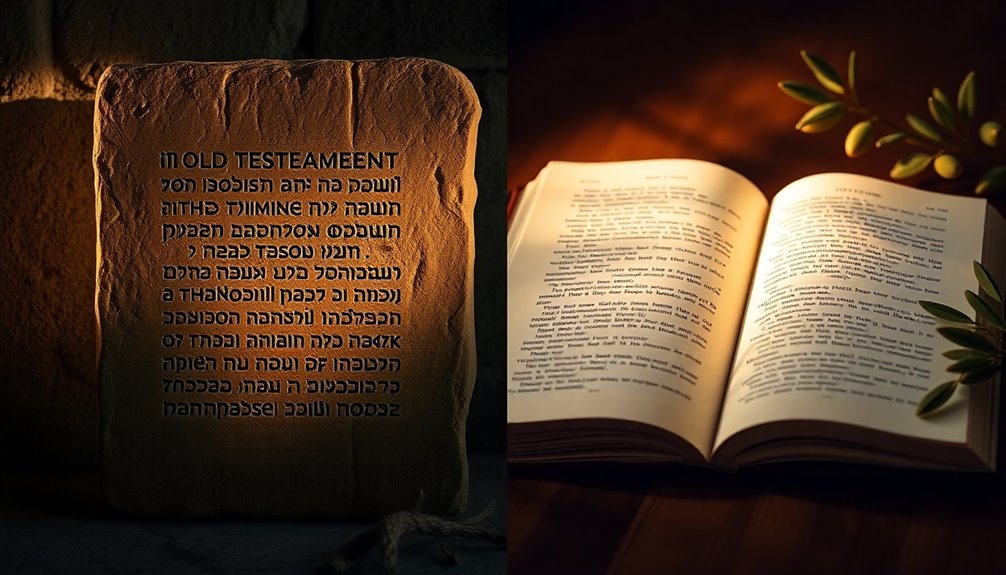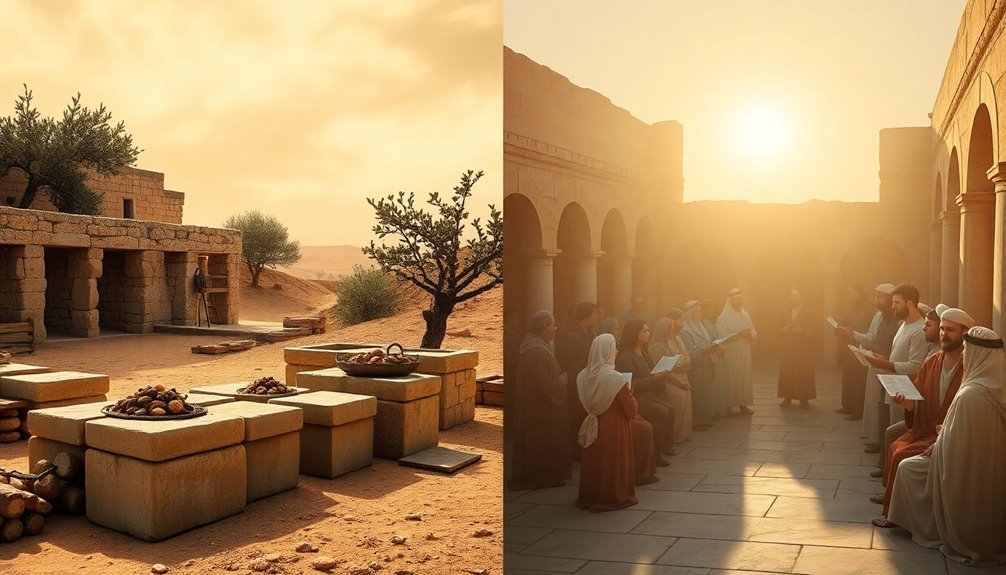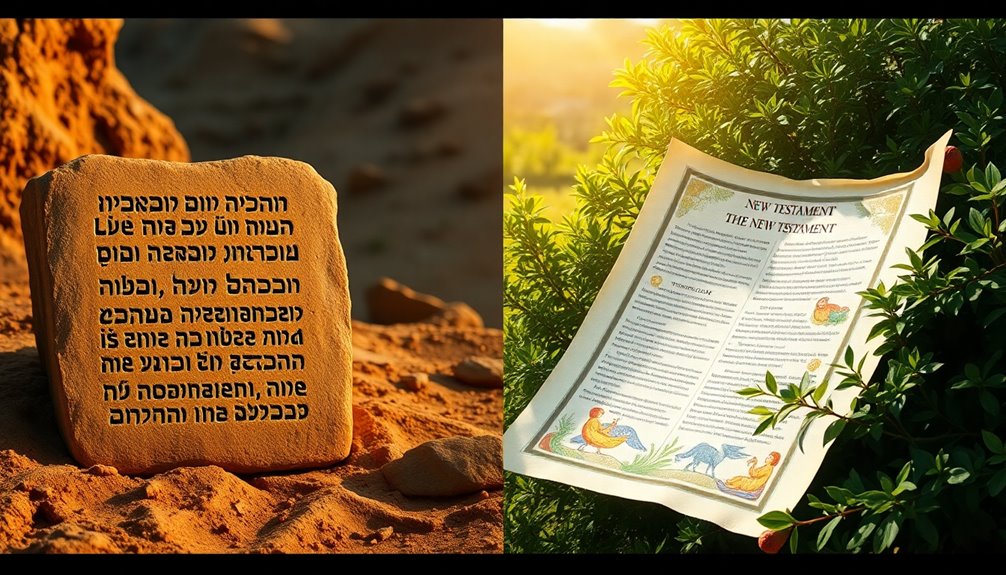The Old Testament and New Testament form two vital sections of the Christian Bible. You'll find that the Old Testament focuses on God's covenant with Israel, featuring laws, prophecies, and historical narratives. It's about obedience and the establishment of the sacrificial system. In contrast, the New Testament centers on Jesus Christ and introduces the New Covenant of grace and salvation. It emphasizes faith over law and reshapes the relationship between God and humanity. Understanding these differences enriches your faith journey, revealing deeper connections between the two Testaments that might surprise you.
Key Takeaways
- The Old Testament focuses on God's relationship with Israel, while the New Testament centers on Jesus Christ and the early Christian church.
- The Old Covenant emphasizes laws and rituals for righteousness, whereas the New Covenant highlights grace, faith, and personal relationships with God.
- Historical contexts differ significantly, with the Old Testament rooted in ancient Israel's covenant life and the New Testament reflecting the emergence of the Christian faith.
- The sacrificial system in the Old Testament foreshadows the ultimate sacrifice of Jesus, fulfilling the need for atonement in the New Testament.
- Daily devotional practices and group studies draw insights from both Testaments, enhancing understanding of their continuity and theological implications.
Introduction

The Bible is a profound text that's divided into two main sections: the Old Testament and the New Testament. The Old Testament consists of 39 books, primarily detailing God's relationship with Israel and laying the foundations of the Jewish faith. You'll find various genres here, including historical narratives, laws, poetry, and prophecies that explore themes like creation and covenant.
In contrast, the New Testament contains 27 books that focus on the life and teachings of Jesus Christ and the early Christian church. Written in a much shorter timeframe, roughly between 50-100 AD, it emphasizes a shift from the Old Covenant, which was based on law, to the New Covenant grounded in grace through faith in Jesus.
This transition is fundamental for understanding Christianity's core beliefs, as the New Testament fulfills many themes established in the Old Testament. By examining these two sections, you can appreciate the depth and continuity of biblical narratives that shape the religious landscape today.
The interplay between the Old Testament and New Testament provides insights into God's plan, enriching your spiritual journey and understanding of these sacred texts.
Scriptural Basis for Comparison

When you compare the Old and New Testaments, it's crucial to look at primary and secondary Bible references that highlight their differences and connections.
For instance, key prophecies in the Old Testament set the stage for the fulfillment found in the New Testament.
Understanding these references helps you see how the themes of law and grace evolve throughout the scriptures.
Primary Bible References
In examining the primary Bible references that highlight the differences and continuities between the Old and New Testaments, you'll find significant scriptural foundations.
The Old Testament, particularly Genesis 12:1-3, establishes God's covenant with Abraham, laying the groundwork for Israel's history. Prophetic references, like Isaiah 53, foreshadow the suffering servant, a role fulfilled by Jesus in the New Testament as seen in Matthew 27:27-31 during His crucifixion.
The Old Testament law outlined in Exodus 20:1-17 provides a moral framework that Jesus addresses in the New Testament. In Matthew 5:17-20, He claims to fulfill the law, bridging the two Testaments.
Sacrifice is first introduced in Leviticus 16:30-34, detailing the Day of Atonement, which prefigures Christ's ultimate sacrifice as described in Hebrews 9:26-28.
Moreover, the transition from the Old Covenant to the New Covenant is explicitly discussed in Jeremiah 31:31-34, and this promise is fulfilled in the New Testament during the Last Supper, as seen in Luke 22:20.
Here, the Testament reveals a new relationship between God and humanity through Jesus, emphasizing continuity and transformation.
Secondary Bible References
Exploring secondary Bible references provides deeper insights into the connections between the Old and New Testaments. The Old Testament lays the groundwork for understanding God's covenant with Israel, revealing laws and prophecies that anticipate the coming Messiah. For instance, Jeremiah 31:31-34 foretells a new covenant, signaling a shift in God's relationship with humanity.
In the New Testament, you see the fulfillment of these prophecies through Jesus Christ. Matthew 5:17 illustrates this when Jesus states He came to fulfill the law and the prophets, emphasizing that the Old Testament's sacrificial system is now replaced by His ultimate sacrifice, as explained in Hebrews 10:4-10. This transition marks a significant evolution in understanding atonement and worship.
Moreover, the moral teachings of the Old Testament, such as the Ten Commandments (Exodus 20:1-17), are reinterpreted in the New Testament through Jesus' teachings on love and grace, particularly in Matthew 22:37-40.
Finally, the shift from the Old Covenant, focused on physical blessings for Israel, to the New Covenant, which promises spiritual blessings for all believers (Ephesians 1:3), showcases the transformative nature of God's plan.
Religious Practices of Ancient Israel

Religious practices in ancient Israel revolved around a vibrant system of rituals and community observances that shaped daily life. Central to these practices was the sacrificial system found in the Old Testament.
You'd witness various offerings, such as burnt, sin, and peace offerings, made at the Tabernacle and later the Temple. These sacrifices served to atone for sins and express devotion to God, reinforcing the covenant relationship between God and His people.
Another key practice was the observance of the Sabbath, a weekly day of rest dedicated to worship. This day emphasized the importance of the covenant relationship as outlined in the Torah.
Festivals like Passover, Shavuot, and Sukkot also played a significant role, marking pivotal moments in Israel's history and agricultural cycles, and requiring participation from all males.
The priesthood, primarily composed of the Levites, was essential in conducting sacrifices, maintaining the sanctuary, and teaching the Law to the people.
Additionally, ritual purity laws governed daily life, dictating dietary restrictions and purification rites after events like childbirth and illness, ensuring that the community remained holy in their worship.
Theological Implications of Covenants

The rich tapestry of ancient Israel's religious practices sets the stage for understanding the profound theological implications of the covenants outlined in scripture. The Old Covenant, rooted in the Law given to Moses, established a framework for Israel's relationship with God. This covenant included blessings for obedience and curses for disobedience, as detailed in Deuteronomy 28.
However, it also foreshadowed a transformative shift. The New Covenant, introduced through Jesus Christ, fulfills the requirements of the Old Covenant while emphasizing grace, forgiveness, and a personal relationship with God (Hebrews 8:6-13). Prophecies like Jeremiah 31:31 signal this change, highlighting a movement from external adherence to the Law toward an internal transformation of the heart.
The sacrificial system of the Old Covenant, which demanded animal sacrifices for atonement, finds its completion in Jesus, the ultimate sacrifice (Hebrews 10:1-4). The theological implications of these covenants reveal a progression in God's revelation, transitioning from a national identity for Israel to a universal identity for all believers in Christ.
This New Covenant offers spiritual blessings to everyone who's faith, reshaping your understanding of God's relationship with humanity (Galatians 3:26-29).
Misunderstanding Covenant Purpose

Misunderstanding the purpose of the Old and New Covenants can lead to common misconceptions about salvation and God's intentions.
You might think that strict adherence to the law is what earns you favor, but it actually points to our need for grace.
Debunk Common Misconceptions
Many people mistakenly think that the Old Covenant was solely about adhering to laws for righteousness. In reality, its main purpose was to reveal humanity's sinfulness and the desperate need for salvation. The Old Testament laws weren't just a checklist; they pointed toward the grace offered through the New Covenant established by Jesus Christ.
It's crucial to understand that the Old Covenant provided physical blessings and a national identity for Israel, but the New Covenant offers spiritual blessings and a personal relationship to God for all believers. Misunderstandings often arise when interpreting Old Testament prophecies about the Messiah without recognizing their fulfillment in the New Testament through Jesus' life, death, and resurrection.
Transitioning from the Old to the New Testament doesn't mean rejecting the Old Covenant. Instead, it signifies its fulfillment and transformation into a New Covenant based on grace rather than law.
Embracing this perspective helps clarify the relationship to God and highlights how the Old Testament vs New Testament serves as a continuum, not a contradiction. Understanding these nuances can enrich your faith and deepen your appreciation for the biblical narrative.
Covenant Relevance Today
Understanding the relevance of the covenants today requires recognizing how their purposes differ and how they interact within the overarching narrative of Scripture. The Old Testament features the Old Covenant, which revolves around laws and rituals that defined Israel's relationship with God. In contrast, the New Testament introduces the New Covenant through Jesus, focusing on grace and faith rather than strict legal adherence.
Misunderstanding the purpose of the Old Covenant can lead you to emphasize legalism, potentially overshadowing the transformative relationship and spiritual blessings available in the New Covenant. Key passages, like Jeremiah 31:31, promise a New Covenant that replaces the Old, indicating a significant shift in how God relates to humanity.
The New Testament clarifies that the law's original purpose was to reveal humanity's need for salvation, fulfilled in Christ. This reinforces that the Old Covenant wasn't meant to grant salvation.
Understanding the distinction between these covenants helps you appreciate the continuity of God's redemptive plan while recognizing the new relational dynamic established through Jesus' sacrifice. Embracing this perspective enriches your faith and deepens your understanding of God's love and grace today.
Daily Devotional Practices

When you think about daily devotional practices, consider how daily prayer reflections can enhance your spiritual journey.
Group Bible study activities offer a chance to connect with others, deepening your understanding of scripture together.
Both practices help you grow in faith, drawing insights from both the Old and New Testaments.
Daily Prayer Reflections
In daily prayer reflections, you can draw profound insights from both the Old and New Testaments. The Old Testament emphasizes themes of covenant, law, and God's character, encouraging you to meditate on repentance and faithfulness, especially in texts like Psalms and Proverbs. These reflections can deepen your understanding of God's enduring promises.
In the New Testament, prayer takes on a personal tone through the teachings of Jesus. The Lord's Prayer (Matthew 6:9-13) serves as a model for daily communication with God, highlighting forgiveness, provision, and spiritual growth. By incorporating scriptures from both Testaments into your daily prayers, you can appreciate the continuity of God's plan, where Old Testament prophecies about the Messiah find fulfillment in the New Testament accounts of Jesus' life.
Engaging in prayerful reflection on key figures such as Abraham in the Old Testament and Paul in the New Testament can provide valuable insights into faith and obedience.
Additionally, contrasting the Old Covenant with the New Covenant allows you to appreciate the shift from law to grace, as expressed in Hebrews 8:6-13. This holistic approach enriches your prayer life and strengthens your relationship with God.
Group Bible Study Activities
Group Bible study activities can transform your daily devotional practices into a rich, communal experience. By reading passages from both the Old and New Testaments, you'll grasp the continuity of God's message and His unfolding plan of redemption.
Before diving into scripture, take a moment to pray; this invites personal reflection on how the themes of grace in the New Testament connect with the covenant and laws established in the Old Testament.
Journaling insights from your readings encourages deeper engagement with key themes, like the fulfillment of Old Testament prophecies in the New Testament. Discussing specific verses, such as the concept of sacrifice, can illuminate the transition from animal sacrifices in the Old Testament to Jesus as the ultimate sacrifice in the New Testament.
Utilizing study guides that highlight these connections enhances your understanding of the biblical narrative and its application to daily life. As you explore the testimony of Jesus together, you'll not only grow in knowledge but also foster a sense of community and shared faith.
These activities will deepen your relationship with God and your understanding of His word, making your devotional practices more meaningful.
Key Takeaways and Insights

Understanding the differences between the Old and New Testaments reveals profound insights into the evolution of faith and theology. The Old Testament, with its 39 books, lays the groundwork for understanding creation, Israel's history, and God's law. It emphasizes prophecies about the coming Messiah, setting the stage for the New Testament's focus on Jesus Christ.
In contrast, the New Testament consists of 27 books that center on Jesus' life, teachings, and the formation of the church, illustrating the fulfillment of those ancient prophecies through His birth, death, and resurrection.
Key themes also shift significantly. The Old Testament revolves around covenant, law, and redemption, while the New Testament introduces grace, salvation, and the Kingdom of God. The sacrificial system in the Old Testament, which required animal sacrifices for atonement, finds its ultimate reinterpretation in Jesus Christ, who embodies the final sacrifice, erasing the need for such rituals.
Lastly, the historical contexts differ greatly. The Old Testament spans centuries before Christ, while the New Testament emerges just decades after His death, reflecting the early Christian community's beliefs and practices that continue to shape faith today.
Additional Resources

Exploring the differences between the Old and New Testaments opens the door to a wealth of resources that can deepen your study and understanding. The Christian Bible consists of 39 books in the Old Testament and 27 books in the New Testament, each offering unique insights into faith and history.
Online platforms like BibleGateway and Blue Letter Bible provide various translations and commentaries, allowing you to delve deeper into the texts.
Consider using a "Chronological Bible," which arranges the books in the order of events. This format helps you connect narratives across the Old and New Testaments, enhancing your grasp of the overarching story.
Study guides and workbooks, such as those from "The Bible Project," offer visual aids and thematic breakdowns that clarify key concepts and interconnections.
Additionally, enrolling in academic courses or seminars through platforms like Coursera or local theological schools can enrich your understanding of the historical and cultural contexts that shape what the Testament tells.
With these resources at your fingertips, you're well-equipped to navigate the profound teachings found in both the Old and New Testaments.
Frequently Asked Questions
Is Jesus Mentioned in the Old Testament?
No, Jesus isn't mentioned by name in the Old Testament, but you'll find many prophetic references that Christians believe point to Him.
For instance, prophecies like Isaiah 7:14 and Micah 5:2 hint at His birth. The concept of the suffering servant in Isaiah 53 is viewed as a foreshadowing of His sacrificial death.
How Is God Different in the Old and New Testament?
When you explore how God is depicted, you notice a shift in focus.
In one context, He emphasizes strict laws and justice, revealing the seriousness of sin and consequences.
In another, you see His grace and mercy shine through, especially in the teachings of Jesus.
This contrast highlights God's desire for a personal relationship with you, moving from national covenants to a universal call for faith and reconciliation with all humanity.
Do Christians Believe in the Old Testament?
Yes, you'll find that Christians do believe in the Old Testament. They view it as sacred scripture, essential for understanding God's character and the foundation of their faith.
The Old Testament contains key themes like creation and covenant, which help you grasp the context of Jesus' life and teachings.
Many Christians see it as an integral part of their beliefs, linking it to the New Testament's message of salvation through Christ.
Why Is the Bible Divided Into Old and New Testaments?
The Bible's division into two parts reflects a significant shift in divine revelation. Each section serves a unique purpose, with one laying the groundwork for God's promises and the other revealing their fulfillment.
This separation also highlights the progression of faith, showing how God interacted with humanity over time. By understanding this division, you gain insight into the overarching narrative of God's plan and the importance of both sections in shaping spiritual beliefs.










